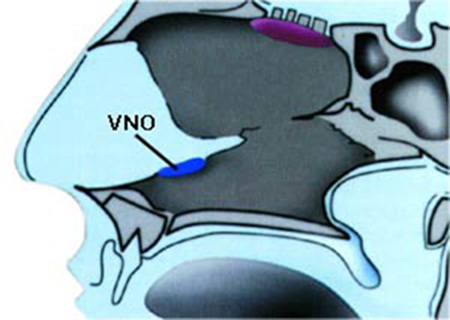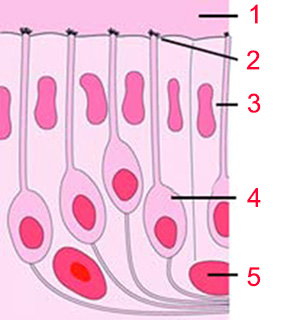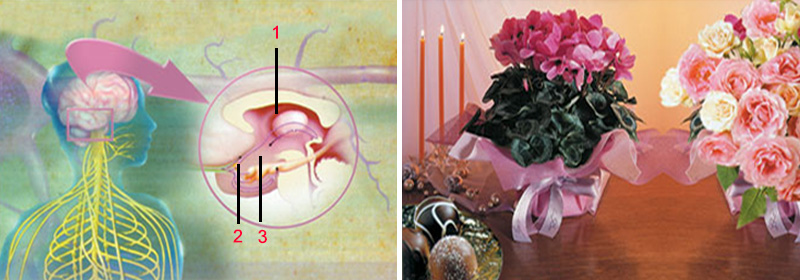Chemical substances are often imagined to be perceived only through the senses of smell and taste. Yet this is not the case, because there are also at least two known systems: pain receptor nerves and the vomeronasal organ.
Throughout the nasal cavity, including the olfactory region, are dispersed the ends of pain-receptor nerves that react to stimuli that lead to feelings of pressure, pain, heat and cold. For example, these nerves transmit to the brain signals that cause the sharp, burning sensation of ammonia. Were it not for the pain receptors in your nose, you could not detect various gasses that are harmful to your health. Thanks to the design in question, however, unfortunate consequences that might result in injury, or even death, are avoided.
In comparison with scent receptors, these nerves are less sensitive and are thought to play an important complementary role in scent perception.46 Menthol is known to produce a cooling sensation in normal concentrations, but a hot one at high concentrations. The special design at the ends of the pain-receptor cells allows us to perceive this difference.
 |  |
| Left: (Figure 17) The location of the vomeronasal organ (VNO) in the nose. | 1. Nasal cavity, |
Some scent particles produce no effect in the olfactory region. These special chemical signals are known as pheromones. A special organ in the nose has been created to detect pheromones. Known as the vomeronasal organ (VNO), this structure is of a tube- shaped, about 1 millimeter (0.04 inch) in length, and located in the inner part of the nose, just above the cartilage dividing the two nostrils. (Figure 17) It is a different sensory organ whose chief function is to receive the messages carried by pheromones, convert them into a form the brain can understand, and then forward them by means of special nerves directly to the relevant brain regions. (Figure 18) This organ's functions are not yet fully understood, and are the subject of debate among scientists.47
But it has already emerged that the VNO is of vital importance to some insects and animals. For example, the social, reproductive and hunting of snakes with damaged VNOs becomes impaired. Rats with no sexual experience and whose VNOs were surgically removed were unable to mate, although their other organs functioned perfectly.48
We know for certain that there are unknown mechanisms in the olfactory region in our noses. For example, consider the relationship between color and odor sensitivity. This region is light yellow in human beings but brown in dogs. The color element is thought to influence scent detection capacity, although the link between them is not understood.49
Every new piece of scientific research lets us become better acquainted with the marvels of creation. Maybe as-yet-unknown perfect systems in our noses will be brought to light. These will be a new means of giving thanks in the manner that we should to God, the Lord of boundless affection and compassion Who created them.
 |
| Eat of the things which Allah hath provided for you, lawful and good; but fear Allah, in Whom ye believe... (Surat al-Ma'ida: 88) |
As you sit reading these lines, you have practically no awareness of the presence of the clothes you wear, despite their close contact with your skin.
You feel clothes when you first put them on, but that feeling soon disappears, because receptors in your skin stop sending messages to the brain. Were it not for this marvelous system, everyday actions such as wearing clothes would become intolerable. You would also be unable to perceive other signals because your clothes distracted you, and your life would become very difficult indeed.
A similar process applies with the sense of smell. When you enter a restaurant, you immediately perceive the cooking aromas. A short while later, however, you become unaware of them. Yet there has been no reduction in the level of those heavy smells. You have simply grown accustomed to them. A special mechanism known as adaptation causes this change in sensitivity, although the aroma itself does not change in the least.
To grasp the importance of this mechanism, consider the cooks who work in a restaurant kitchen full of dense odors. If their sensitivity to the ambient smells did not decrease, their situation would be exceedingly uncomfortable. And their scent receptors, kept constantly busy, might be unable to detect any dangers—a gas leak, for example.
Frank Zufall, known for his research in this field, states that scent adaptation contains mechanisms50 that are so complex that the processes at the molecular level are still not fully understood. There are thought to be at least three different scent-adaptation mechanisms in the scent receptor cells. In addition, there must also be centers in the brain to monitor the sense organs that either transmit or halt this information.
In that case, how did the scent-receptor and brain cells, themselves consisting of atoms like carbon, nitrogen and oxygen, come to develop an adaptation system, whose details are still unknown? How do they know when, and when not, to go into action? How do they act in the very best manner on your behalf, without your becoming involved in any way?
The answers are clear: This adaptation system in scent perception is one of the innumerable examples of the superior design flawless planning and perfect order to be seen everywhere in the universe. There is absolutely no doubt that such a marvelous order leaves no room for chance. Every component of these flawless systems in our bodies is far too perfect to be accounted for in terms of coincidence. As it is revealed in the Qur'an, "He directs the whole affair from heaven to Earth..." (Surat as-Sajda: 5)
 |
| A cook's sensitivity to smells in the kitchen soon declines in a matter of minutes. In this way, he is not bothered by the intense aromas constantly reaching him and is also able to immediately detect any new odor—such as a gas leak or something burning. |
 |
| Thanks to scent memory, an aroma you smelled as a child can be recognized many years later. |
| ...He knows what is in the heavens, and what is on earth.And Allah has power over all things. (Surah Al 'Imran: 29) |
The sense of smell is closely bound up with memory. The reason you recognize most smells around you with no feelings of unfamiliarity is that every kind of smell is archived with a special code in your scent memory. The moment you encounter an aroma smell, it is identified by application to that archive. A smell you encounter for the first time, which you have never experienced, is interpreted by being compared to other scents. If we did not possess such a memory, smells would be impossible to describe.
Smells also remind us of various events that we experienced in the past. A familiar perfume scented as we walk along the street reminds us of another woman who wears it. The smell of something cooking can evoke a memory of a meal that took place years before. The same aroma can awaken pleasant feelings in one person, but unpleasant emotions in another.
Where, then, are the memories of various scents—and the emotions they evoke perceived anew—preserved over the years? Where is the data bank stored, with its very large capacity for information on thousands of different aromas? The answers are not yet known for certain. But information regarding smells is believed to be collected in the brain’s hippocampus and amygdala.51 (Figure 19)
Results of research on this subject are clear: Your memory serves as a data bank of aromas throughout your life, so long as you suffer no serious illness or accident. Furthermore, it has an active structure rather than a stable one, and renews itself constantly in the light of new experiences.52
Information about a substance you smell for the first time is recorded in memory, making it easy for you to recognize it when you next come across it. Note that cells made up of proteins constitute your olfactory memory, establishing an extensive archive and expanding it as new smells are encountered. As a small comparison, your computer cannot spontaneously update itself. It will remain as it is until you load new programs onto it. Neither did the archival property of the scent memory cells come into being spontaneously. God created them, and their superior design is one of the countless proofs of His mercy and the way that His knowledge enfolds all things. (Surah Ghafir: 7)
One important feature distinguishes olfactory memory from visual and audio memory: Information about smell has a much greater permanence. 53 That is why so many memories are evoked when you perceive a smell originating from a flower, a herb or even from a person. Research has shown that every individual’s own scent is unique, just like a fingerprint.54 (The only exception is with identical twins.) When specially trained dogs follow a suspect, they track the traces of odor of that person’s skin , and can distinguish that suspect by means of his unique scent.
Indeed, the report in the Qur’an describing how the father of the Prophet Joseph (peace be unto him) recognized his son’s scent years later may be pointing to that very fact. His father recognized the smell as being the same scent that the Prophet Joseph (pbuh) had in his childhood, even after the passage of a great many years:
And when the caravan went on its way, their father said, “I can smell Joseph’s scent! You probably think I have become senile.” (Surah Yusuf: 94)
 |
| 1. Hypothalamus, |
| (Figure 19) Information regarding smells is believed to be collected in the hippocampus and amygdala regions of the brain. |
The smell of freshly baked bread, the aroma of pies from a cafeteria, or the smell of freshly ground coffee is all delightful. So attractive are these aromas that they encourage one to taste those foodstuffs. Indeed, in some circumstances, the saliva glands go into action and secrete the saliva necessary to be able to taste. Since your perception of scents is a thousand times sharper than your ability to taste, odors play an important role in the “taste” of foods.55 Yet the relationship between our senses of smell and taste goes even further.
How do you tell blackcurrant jam from strawberry?
If you think the answer is obvious, and that you just have to taste them, you are mistaken, because tasting alone is not enough to tell the difference between the two. If you had no sense of smell, you would describe the taste of both as “sweet,” but not be able to describe their different features.56
 |
| The sense of smell plays a very important role in taste. |
The reason is that we need our sense of smell to be able to perceive the taste of anything we eat, and cannot fully appreciate the flavor of anything without smelling it. What makes something pleasant to eat is the combination of both its taste and aroma. Researchers emphasize this by saying that taste is 75% smell.57
As we know, appetizing smells encourage people to eat and drink. Indeed, people who lose their sense of smell have no great desire for food.58 Remember times when you had a cold or the flu? Your meals had no flavor at such times because scent molecules failed to reach the scent preceptors—for which reason your sense of smell was temporarily lost.
 |
| Who has made the earth your couch, and the heavens your canopy; and sent down rain from the heavens; and brought forth therewith Fruits for your sustenance; then set not up rivals unto Allah when ye know (the truth). (Surat al-Baqara: 22) |
To make this easier to understand, blindfold friends and block up their nostrils, and then ask them to place first, a slice of potato and next, a slice of apple on their tongues. Your friends will be unable to tell which is which, because both cause a mild sweet sensation. It is possible for your friends to give the right answer only if they start chewing, because that will release scent particles that float up through the back of the mouth to reach the scent region in the nose. Potato and apple will then become apparent.
 |
| The sense of smell plays a very mportant role in taste. |
Noteworthy too is that the mouth and nose are ideally positioned in the human body, in very close proximity to one another. An air passage connects the scent perception zone in the nose to the oral cavity. Were it not for that connection and that proximity, or if the scent receptors were located in another part of the body, what would happen?
Any alteration to the current state of affairs would mean a major loss of taste perception, because the mouth, nose and scent perceptors have been created in exactly the right form and locations.
Indeed, it is revealed in the Qur’an that God created human beings within a particular order:
O man! What has deluded you in respect of your Noble Lord? He Who created you and formed you and proportioned you and assembled you in whatever way He willed. (Surat al-Infitar: 6-8)
To summarize, the concept we define as “flavor” is a combination of taste and smell. Therefore, if we had no sense of smell, our sense of taste would have little purpose. In order to perceive flavors, we need the scent receptors in the nose just as much as taste preceptors on the tongue.
No doubt the cooperation between the organs and senses for taste and smell results from a special design. It is perfectly commonplace for conscious humans to agree to work towards some common objective. But similar cooperation among billions of cells devoid of any intelligence of consciousness can be explained in only one way: it is God, the Lord of the worlds, Who placed them at the service of humans and Who keeps them under His control at all moments.
46. G. Ohloff, Scent and Fragrances, Berlin, Heidelberg: Springer-Verlag, , 1994, p.6.: http://www.leffingwell.com/olfaction.htm ![]()
47. A.I. Spielman, J.G. Brand, andW. Yan, “Chemosensory Systems,” Encyclopedia of Life Sciences, June 2000. ![]()
48. Michael Meredith, The Vomeronasal Organ, Florida State University, 2001,: http://www.neuro.fsu.edu/research/vomer.htm. ![]()
49. Tim Jacob, “Olfaction,” 2001, http://www.cf.ac.uk/biosi/staff/jacob/teaching/sensory/olfact1.html. ![]()
50. Frank Zufall and Trese Leinders-Zufall, “The Cellular and Molecular Basis of Odor Adaptation,” Chemical Senses 25, Oxford University Press, 2000, pp.473-481. ![]()
51. R.S. Herz, T. Engen, “Odor memory: review and analysis,” Psychonomic Bulletin and Review 3, 1996, no. 3, pp.300-313. http://www.macalester.edu/~psych/whatap/UBNRP/Smell/memory.html ![]()
52. Tim Jacob, “Olfaction,” 2001, http://www.cf.ac.uk/biosi/staff/jacob/teaching/sensory/olfact1.html. ![]()
53. R.S. Herz and T. Engen, “Odor memory: review and analysis,” Psychonomic Bulletin and Review 3, 1996, no. 3, pp.300-313. ![]()
54. Tim Jacob, “Olfaction,” 2001, http://www.cf.ac.uk/biosi/staff/jacob/teaching/sensory/olfact1.html ![]()
55. Selçuk Alsan, “Yemeklerin Tad›, Kokusu,” Bilim ve Teknik (The Smell and Taste of Foods, Science and Technique)February 1999, pp.98-99. ![]()
56. Disorders of Smell, Macalester College, 2001, http://www.macalester.edu/~psych/whathap/UBNRP/Smell/disorders.html. ![]()
57. Tim Jacob, “Olfaction,” 2001, http://www.cf.ac.uk/biosi/staff/jacob/teaching/sensory/olfact1.html. ![]()
58. “Nutrition and Appetite,” Monell Chemical Senses Center, 1998, http://www.monell.org/ ![]()